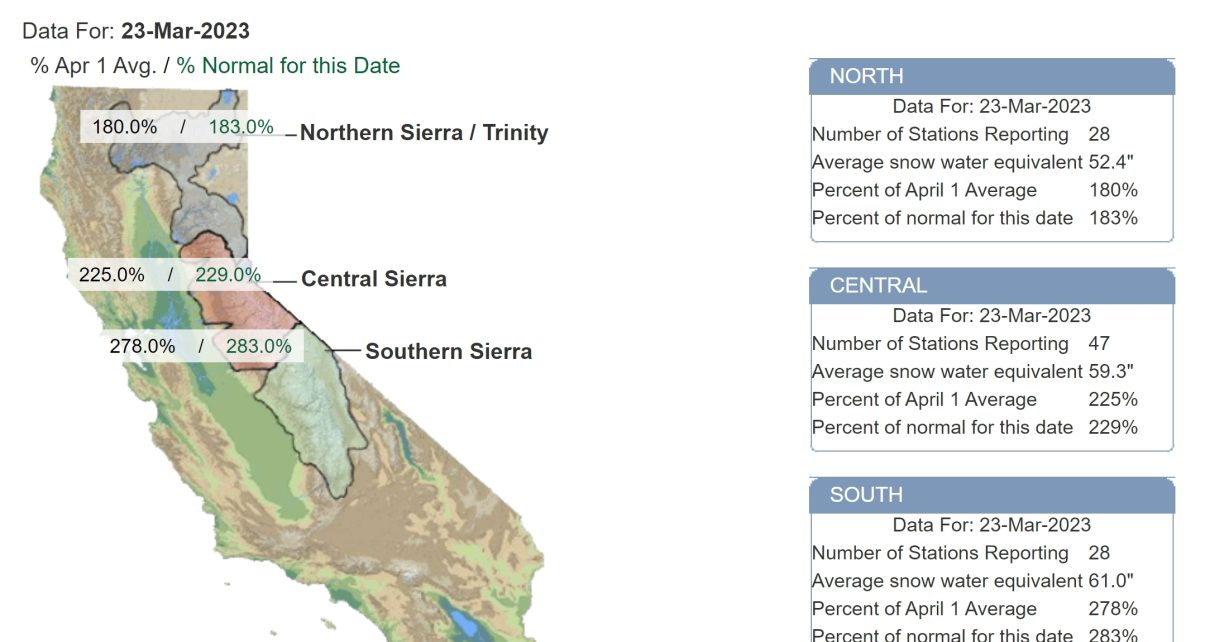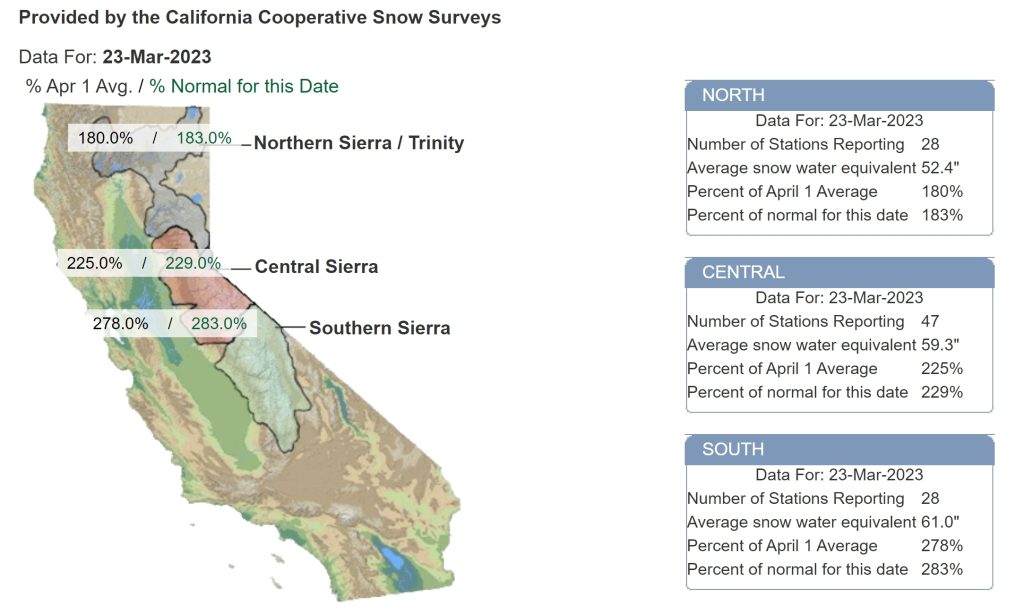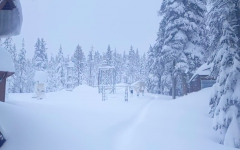
March 2023 Snowpack levels (Photo: cdec.water.ca.gov)
Reservoirs, Snowpack Levels Continue To Rise Across The State Following Latest Atmospheric River Event
California expected to completely exit drought conditions by early April
By Evan Symon, March 24, 2023 2:30 am
The heavy rains and snow that 12th atmospheric river event this year brought continued to break precipitation records across California this week, with reservoir and snowpack levels all but ensuring the state enough water to stave off the drought this year.
Reservoir levels across the state are close to being topped after the storm this week. In January, Lake Shasta stood at 57% of it’s normal levels, with Lake Oroville at 71%. By early March, Shasta was at 84%, with Oroville brimming up to 116%. This week, normal water levels in reservoirs are all over 100%.
This time in 2021, Lake Shasta was at 977 feet MSL (Mean Sea Level), far below the average and even farther below the full pool level of 1,067 feet MSL. In 2022, the situation grew even worse, with the Lake showing severe signs of water loss and a feet MSL of 940. However, when measured on Thursday, the lake was above the average with 1,031 feet MSL, with less than 40 feet to go before reaching full pool level.
Lake Oroville has had a similar story. In the last two years, it has been at a low point of between 720 feet MSL and 740 feet MSL, well below the average and full pool level of 900 MSL. Images of Lake Oroville during this time grew famous due to the visible waterline in the surrounding rocks. But on Thursday, there was less than 45 feet to go before the full pool level, with 856 feet MSL being recorded.

Up in the mountains, record levels are also being experienced. In January, snowpack levels in the mountains were at 174% the average amount. In early March, levels were above 200%. Based on measurements on Thursday, the average snowpack level statewide was at 227%. In the Southern Sierra Range, a main feeder for both the Central Valley and the Los Angeles area, levels were approaching 300%, with snowpack at 283%. As snowpack levels need to be at at least 100% on April 1st to ensure enough water reaches both urban areas and farms for the rest of the year, the levels all but ensure California will escape drought-like conditions for the rest of the year.
Other side effects have been noted as well. Many ski areas have extended ski season until early July due to the sheer amount of snow. Water restrictions caused by the drought are rapidly being lifted across the state. Wildfire season predictions are being tempered down due to the constant rain. And, to top it off, around two-thirds of the state are no longer under drought conditions.

While these are all positives, what does it mean for the rest of the past the April snowpack measuring day?
“Well, it depends how much more rain is coming for one,” explained Jack Wesley, a water systems consultant for farms and multi-family homes, to the Globe on Thursday. “It looks like another band is coming next week, so while it can mean more flooding and damage, it means it is also officially eating into the warmer weather months too.
“More than that though, any final drought restrictions will likely be lifted, especially if the meltwater comes more as a force rather than a trickle. For farms, right now some are flooded, but once that dries out it should be a pretty good year following the last few that have been near bone dry. A lot of areas will be more full of life. We’ve gotten used to scrub-like conditions the last few years, so we’ll be seeing a lot more green this year in all likelihood.
“Right now it’s all dependent on temperatures, how much more rain is coming, and how much we store for when we get a dry spell again. We’ve had a weird last several years weather-wise, so we don’t really know what it can look like right now.”
Snowpack measurements for April are due next week.







This is caused by the environmental people who started fooling with the ratio of gasses in the atmosphere, most obviously CO2 when they have no idea what they are doing. As they horse whip America to bend to their will, all they have done is create a climate catastrophe!
Now, if we can just keep Greasy Gavin away from the dams so he doesn’t let all this water dump straight into the sea, we’ll be set at least for a few years. And, get that Sites project going, too. Just remember, if a democrat touches it, it’s gonna be messed up.
While California may completely exit drought conditions by early April, evil Newsom and Marxist Democrats will ensure that all the water collected is allowed to flow out to the ocean and probably by next fall they’ll claim that California is back in drought conditions again? It’s how they control Californians by forcing water scarcity?
Hey Newsom – Hands OFF OUR water!!!
You are a public SERVANT, not a TYRANT/KING, OK??? You are owed a FIDUCIARY RESPONSIBILITY to the citizens of this state and need to PROTECT these scarce resources for our benefit….
Tell your WEF bosses to go pound sand on this one, OK???
First, Jerry Brown, and now Gavin Newsom has declared drought as the new normal. And like every “climate change” prediction by the Democrats, it has been proven false.
There has not been one climate change prediction that has some true. Not one. Anyone with a brain should stop believing these lying Democrats.
groundwater needs to recover asap and future water management needs restoring groundwater as a higher priority.
Then, a new water contract with socal needs to curtail water to them when the rains don’t come